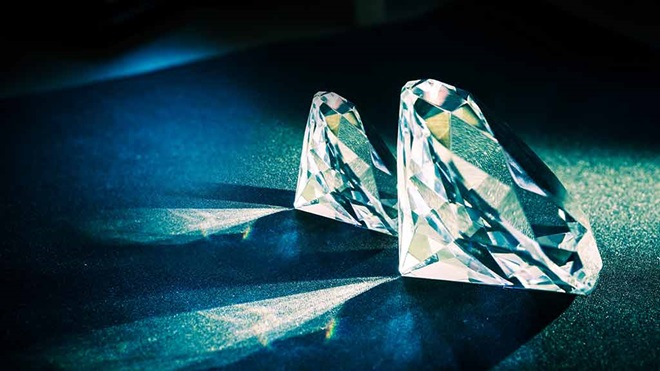Diamonds, often hailed as the ultimate symbol of luxury and elegance, are typically formed under extreme natural conditions deep within the Earth’s crust. However, technological advancements have enabled the production of diamonds in laboratory settings, offering an eco-friendly and cost-effective alternative to traditional mining. Two of the most prominent methods for creating lab diamonds are High Pressure High Temperature (HPHT) and Chemical Vapor Deposition (CVD). While both methods are capable of producing high-quality diamonds, they differ significantly in their processes, characteristics, and applications. In this article, we will explore the key differences between HPHT and CVD diamond production and discuss their respective advantages and disadvantages.
What is HPHT (High Pressure High Temperature)?
High Pressure High Temperature (HPHT) is one of the oldest methods of synthesizing diamonds in the lab. The process closely mimics the natural conditions under which diamonds are formed beneath the Earth’s surface. By subjecting carbon to high pressures (around 5 GPa) and high temperatures (over 1,300°C), scientists can create diamonds in a controlled environment.
How HPHT Works
The HPHT method involves placing carbon (usually in the form of graphite) into a metal solvent, such as iron or nickel, within a pressure vessel. The vessel is subjected to extremely high pressures and temperatures, simulating the conditions found in the Earth’s mantle. The carbon atoms then crystallize into diamond structures over time. The process is highly energy-intensive but produces diamonds with certain characteristics that make them distinct.
Characteristics of HPHT Diamonds
HPHT diamonds typically exhibit a distinctive set of characteristics:
- Color: HPHT diamonds are often produced in a yellow or brown color, though colorless diamonds can be produced with advanced techniques.
- Inclusions: HPHT diamonds may contain metallic inclusions from the solvent used in the process, which can sometimes be visible under magnification.
- Cost: Due to the high energy requirements and advanced machinery needed for HPHT, diamonds produced using this method are often more expensive than CVD diamonds.
What is CVD (Chemical Vapor Deposition)?
Chemical Vapor Deposition (CVD) is a more modern and increasingly popular method of creating synthetic diamonds. In contrast to hpht vs cvd uses a process that involves the chemical vaporization of a carbon-containing gas, such as methane, to form diamond layers.
How CVD Works
In the CVD process, a thin slice of a diamond seed is placed inside a vacuum chamber. A carbon-rich gas, such as methane, is introduced into the chamber, and the gas is heated using microwave radiation or a hot filament. The heat breaks down the methane gas, causing carbon atoms to deposit onto the seed, where they crystallize into a diamond structure. Over time, this process builds up layers of diamond material, creating larger diamonds.
Characteristics of CVD Diamonds
CVD diamonds have some distinct features that set them apart from HPHT diamonds:
- Color: CVD diamonds tend to be colorless or near-colorless, making them ideal for use in jewelry. However, they can sometimes have a brownish tint.
- Inclusions: CVD diamonds often exhibit fewer metallic inclusions compared to HPHT diamonds, though they may still contain other types of inclusions, such as gas bubbles.
- Cost: CVD diamonds are generally more affordable than HPHT diamonds because the process requires less energy and can be more scalable.
HPHT vs CVD: Key Differences
While both HPHT and CVD produce high-quality diamonds, their methods and outcomes differ significantly. Here are some key differences:
1. Production Process
- HPHT: Mimics natural diamond formation through extreme heat and pressure, involving a metal solvent to crystallize the carbon atoms.
- CVD: Uses carbon-rich gas and microwave radiation or a heated filament to deposit carbon atoms onto a seed in a vacuum chamber, forming diamond layers.
2. Diamond Color
- HPHT: Tends to produce diamonds with yellow, brown, or occasionally colorless hues, with the potential for more color variation.
- CVD: Generally produces colorless or near-colorless diamonds, though slight browning may occur.
3. Inclusions
- HPHT: May have metallic inclusions from the solvent used in the process, which are often visible under magnification.
- CVD: Has fewer metallic inclusions but may contain other types of inclusions such as gas bubbles.
4. Cost
- HPHT: More expensive due to higher energy consumption and advanced machinery required for the process.
- CVD: More cost-effective because of lower energy requirements and scalable production.
5. Applications
- HPHT: Often used for industrial applications where diamond toughness and resistance to wear are essential.
- CVD: Ideal for both industrial applications and high-quality gem-grade diamonds used in jewelry.
Advantages and Disadvantages of HPHT vs CVD
HPHT Diamond Advantages:
- Natural Appearance: HPHT diamonds are often considered more “natural” in their appearance due to their formation method, closely resembling mined diamonds.
- Toughness: HPHT diamonds are typically harder and tougher, making them well-suited for industrial uses like cutting tools and abrasives.
HPHT Diamond Disadvantages:
- Higher Cost: The process is energy-intensive and requires expensive equipment, lab diamonds, leading to higher production costs.
- Limited Color: While HPHT can produce colorless diamonds, it typically results in diamonds with yellow or brown hues, which may not appeal to all consumers.
CVD Diamond Advantages:
- Cost-Effective: CVD diamonds are more affordable to produce due to lower energy consumption and scalability.
- Fewer Inclusions: CVD diamonds tend to have fewer visible inclusions, especially metallic inclusions, which results in cleaner diamonds.
- Color Range: CVD diamonds can be produced in near-colorless or colorless forms, making them ideal for use in fine jewelry.
CVD Diamond Disadvantages:
- Process Time: The CVD process can take longer to create larger diamonds, potentially limiting production speeds.
- Inclusion Types: While fewer metallic inclusions are present, CVD diamonds may still contain other types of inclusions, such as gas bubbles or growth lines.
Conclusion: HPHT vs CVD – Which is Better?
The choice between HPHT and CVD ultimately depends on the intended application and the desired characteristics of the diamond.
- If you are looking for affordable, high-quality, and near-colorless diamonds for use in jewelry, CVD might be the better option. Its cost-effectiveness, cleaner appearance, and scalability make it ideal for mass production.
- If you need a diamond for industrial use, or if you prioritize the natural appearance and toughness of the diamond, HPHT may be more suitable, especially for its ability to create more durable and unique diamond qualities.
Both HPHT and CVD technologies continue to evolve, offering consumers more options and enabling the lab-grown diamond market to expand rapidly. Regardless of the method, the end result is a stunning diamond that is indistinguishable from a mined counterpart, providing a sustainable and ethical alternative to traditional diamond mining.



